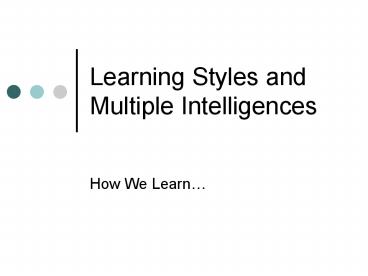Learning Styles and Multiple Intelligences - PowerPoint PPT Presentation
1 / 18
Title:
Learning Styles and Multiple Intelligences
Description:
often rely on one or two predominantly. need to use our best style to learn effectively ... primarily through person-to-person communications and relationships ... – PowerPoint PPT presentation
Number of Views:1701
Avg rating:3.0/5.0
Title: Learning Styles and Multiple Intelligences
1
Learning Styles and Multiple Intelligences
- How We Learn
2
Learning Styles
- are the unique ways in which individuals go about
gathering information, sorting it out, and making
decisions - knowing and understanding how you use your
learning style is an insightful and useful tool - the major abilities include felling, observing,
thinking, and doing a combination of any two is
a learning style
3
Four Learning Styles
- inventories ask individuals to react to four
different dimensions of learning- feeling,
observing, thinking, and doing - plotting the responses on a grid enables us to
determine the four learning styles- enthusiastic,
imaginative, logical, and practical
4
Enthusiastic Learners
- combine feeling and doing
- get involved with lots of new activities
- operate on a gut reaction
- depend on others opinions, feelings, and
information - involve and inspire others
- seek out new experiences
- like risks, excitement, and change
- dislike routines
- adopt well to situations
- are impulsive
- learn by doing
5
Imaginative learners
- combine feeling and observing
- see the whole picture
- use imagination
- create with emotions aesthetic interest
- are oriented to relationships with people
- observe and ask questions
- are good at imagining themselves in different
situations - are casual, calm, friendly
- avoid conflict can not be pushed until ready
- like assurance from others
- learn by listening and sharing ideas or by
modeling
6
Practical learners
- combine thinking and doing
- apply ideas to solve problems
- make use of theories
- search and solve
- test hypotheses objectively
- are unemotional
- use logic and take action
- speculate on alternatives
- like to be in control
- set up projects, pilots with research
- act independently then seek feedback
- use factual data
- are responsible take action
- learn by testing probabilities and drawing
conclusions
7
Logical learners
- combine observing and thinking
- are good theory builders
- put ideas together to form new models
- synthesize
- are organized
- redesign, retest, and digest
- calculate the probabilities
- react slowly and want facts
- work independently
- avoid over involvement
- analyse and critique
- are rational, logical, and complete
- learn by thinking through ideas individually and
organizing a plan or odel
8
Our Home Style
- have all four learning styles
- often rely on one or two predominantly
- need to use our best style to learn effectively
- teachers should try to determine the individual
styles and plan accordingly
9
Multiple Intelligences
- a theory that emerged from the studies of Howard
Gardner and Project Zero (Harvard) - states that intelligence is a pluralistic
phenomenon - eight intelligences have been identified-
logical-mathematical visual-spatial
bodily-kinesthetic musical-rhythmic naturalist
interpersonal intrapersonal and
verbal-linguistic - posits that all individuals are capable of all
intelligences but that some develop more than
others
10
Logical Mathematical Intelligence
- referred to as scientific thinking
- deals with inductive and deductive thinking,
reasoning, numbers, and the recognition of
abstract patterns - characterized by ability to use abstract symbols
and formulae, calculate, decipher codes, work
with graphic organizers, create/solve puzzles,
analyse statistics, and problem solve
11
Visual-Spatial Intelligence
- relies on the sense of sight and being able to
visualize objects - includes the ability to create internal mental
images and pictures - characterized by the ability to actively imagine
connections, associate colours and textures,
draw, visualize, mind map, create
collages/montages, paint, create abstract
patterns/designs, pretend/fantasize, and sculpt
12
Bodily-Kinesthetic Intelligence
- related to physical movement and knowing the body
including the motor cortex which controls bodily
motion - typified by use of body language/gestures,
tableaux, ability to choreograph dance, gymnastic
routines, create models to show how something
works, create physical routines, perform
skits/role play/mime, or create/perform sports
games
13
Musical-Rhythmic Intelligence
- based on the recognition of tonal patterns
including environmental ones and on a sensitivity
to rhythm and beat - characterized by the ability to use natural
sounds, use instrumental sounds, compose/create
music, perform music, understand percussion
vibrations, use raps to communicate, produce
rhythm/beats, create songs, recognize tone
dimensions, and produce vocal sounds/tones
14
Naturalist Intelligence
- deals with the recognition, appreciation, and
understanding of flora and fauna - characterized by the ability to recognize
patterns in the universe, care for
plants/animals, conserve in nature, appreciate
the environment, perform hands-on labs, utilize
field trips, observe nature, simulate nature,
classify species, use sensory stimulation
exercises
15
Interpersonal Intelligence
- operates primarily through person-to-person
communications and relationships - characterized by the ability use collaborative
skills, use cooperative learning strategies,
offer sensitive feedback, work in groups, be
intuitive, jigsaw, communicate person-to-person,
receive feedback, sense other peoples motives
16
Intrapersonal Intelligence
- relates to inner states of being, self
reflection, and meta-cognition as well as an
awareness of spiritual realities - characterized by the ability to alter ones state
of consciousness, process personal emotions,
focus/concentrate, reason at a higher order, know
oneself, think about ones own thinking
(metacognition), pay conscious attention to ones
own life experiences, reflect silently, apply
appropriate thinking strategies
17
Verbal-Linguistic Intelligence
- relates to words and language
- characterized by the ability to write creatively,
make verbal presentations, use humour, speak in
an impromptu manner, trace ones own thoughts in
writing, create poetry, read effectively,
storytell, debate convincingly, and learn/use new
vocabulary
18
Teaching the Multiple Intelligences
- try to assess individual styles
- attempt to plan lessons and units that address a
variety of learning styles/intelligences - provide resources for each of the different
intelligences - provide opportunities for students to present
utilizing a variety of formats































